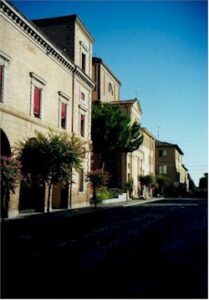Address: Via Emilia
Description: The church of S. Francesco in Castel Bolognese dates back to 1702 and was built on the design by the Roman architect Francesco Fontana on the already existing church of 1422 (dedicated to Santa Lucia). Together with the church, the adjacent convent (that today houses the Municipal Residence) and the bell tower were also restored. The church had to undergo the test of a first earthquake in 1781, the wrath of Napoleon (with the removal of the minor friars and the passage of the convent to the government) and a second earthquake in 1854, which caused the cupola to fall. In 1866 repair works were completed, whilst one year later the church was devolved as state property. In 1932 the temple was included as one of the most important monuments of the province of Ravenna, but underwent further damages during the Second World War and was only opened again to the public in 1965.The hurried restoration works after the war deprived the church of its bell tower and the vestry overlooking the piazza. The first chapel to the right is dedicated to SS. Crocifisso, where the wooden crucifix dates back to the 15th century; at the extremity of the cross plan there is the 17th century chapel of the Blessed Virgin of the Immaculate Conception in Baroque style, of which the bottom part is occupied by a monumental walled-in altar piece with two monuments to the sides. The altar was erected in honour of the Virgin Mary has a blunt urn. At the centre of the chapel is the statue of the Madonna in a niche that can be attributed to the school of Jacopo della Quercia. The third chapel is dedicated to Sant’Antonio of Padova with a statue of the saint in the centre and an original wooden altar (17th century), whilst in the main chapel the only original element is the marble altar of the 17th-18th century. This altar has a modern altar piece by Domenico Matteucci and a canvas by Ferrau Tenzoni. The back wall of the left cross vault chapel was occupied by the 17th century altar-shrine by Bragaldi, also known as “Tutti i Santi” (all saints), containing around 600 holy relics. Finally, the last chapel of the church, once dedicated to San Giuseppe of Copertino, is now dedicated to Sacro Cuore di Gesu (Sacred Heart of Jesus); the painting depicting I Protettori di Castel Bolognese (the Protectors of Castel Bolognese – 1607) is the work of the Faentine Giovan Battista Bertucci Junior. The original simulacrum of the Madonna of the Immaculate Conception is represented by polychrome terracotta of the 15th century of an anonymous artist and currently attributed to a Tuscan artist of the second half of the 1400’s. The statue is not visible to worshippers in its real aspect, as according to popular tradition of Castel Bolognese, it is covered with silk capes and clothing. The right hand holds up a small castle, whilst before it held up a flowered palm. During processions it is decorated with a “pettorina” (chest plate) and a crown is placed on the head of the statue. The recovery of the statue is surrounded by legend, but it is certain that its protection was sought as far back as 1509 for defending the town from groups of mercenaries, in 1630 on occasion of a violent plague and again in 1781, the year of the earthquake. The statue was crowned by the hand of Cardinal Giovanni Battista Nasalli Rocca, archbishop of Bologna, in 1931. The Virgin is celebrated every year during the three days of Pentecost. The importance of this simulacrum is confirmed by the numerous votive tablets exhibited in the chapel and left by the devoted to thank the Madonna for having supported their cause.



